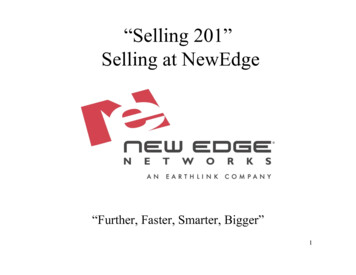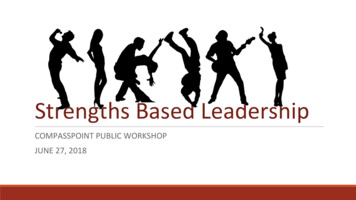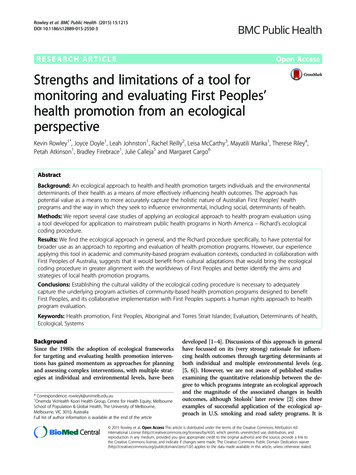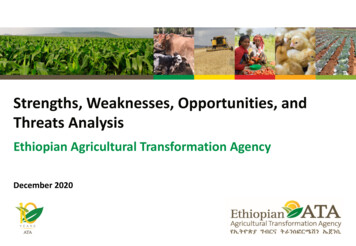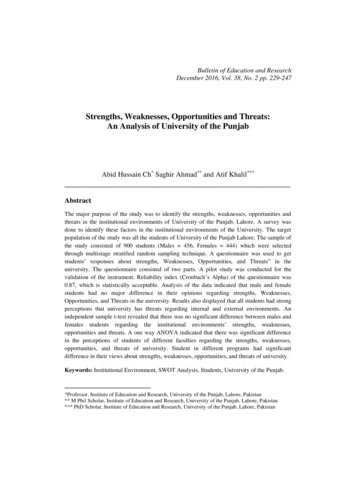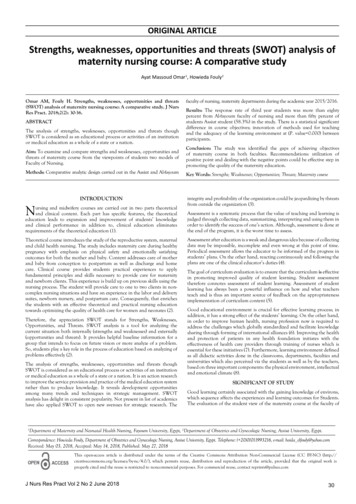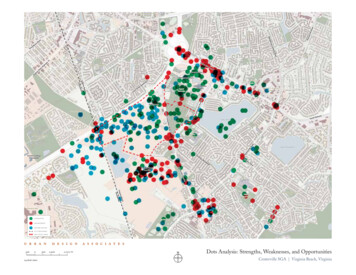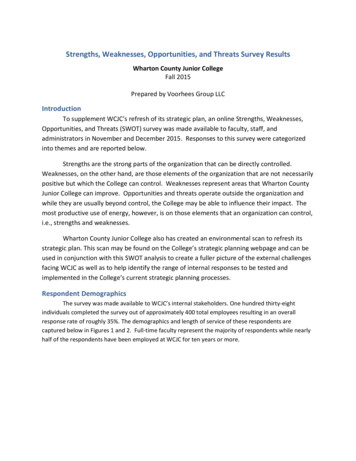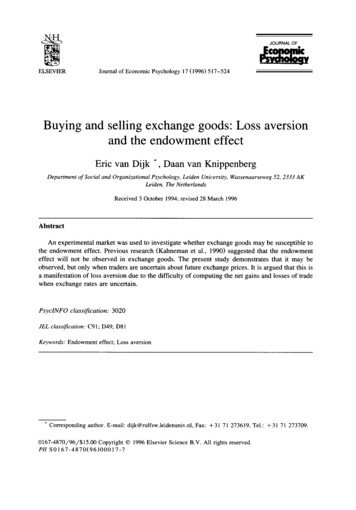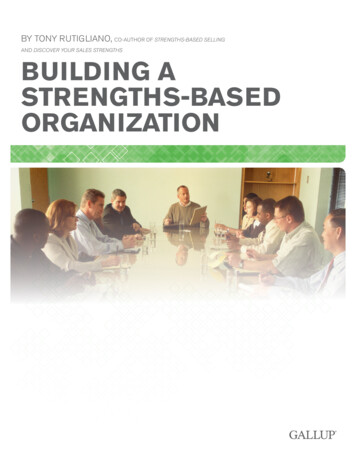
Transcription
BY TONY RUTIGLIANO, CO-AUTHOR OF STRENGTHS-BASED SELLINGAND DISCOVER YOUR SALES STRENGTHSBUILDING ASTRENGTHS-BASEDORGANIZATION
B uilding a S trengths -based O rganizationFor more information about Gallupand our solutions for optimizingbusiness performance, please visitconsulting.gallup.com or contactSarah Van Allen at 202.715.3152 orsarah van allen@gallup.com.Copyright 2011-2012 Gallup, Inc. All rights reserved. Gallup , Gallup Consulting , StrengthsFinder , and Clifton StrengthsFinder are trademarks of Gallup, Inc.
Building a Strengths-Based OrganizationThroughout the world, people spend more time working than in nearly any other pursuit.Yet in a recent survey, they rank primary paid work as one of their least enjoyable activities.Further, individuals say spending time with their supervisor is, on average, the worst part oftheir day.1It does not have to be that way. Through extensive research and studies of clients’experiences, Gallup has found that employees who have the opportunity to do what theydo best at work every day experience a wide range of positive outcomes. A recent study2assessed mood in the moment and throughout the day for people with and without theopportunity to do what they do best in their workplaces. The results, as shown below,indicate that employees who are able to do what they do best at work have much higherlevels of interest, energy, and progress throughout the workday.Employees Who Use Their Strengths at Work Experience Positive OutcomesLevel5.0Making Progress4.5Enjoyment at Work4.0Happy3.5Using StrengthsLike Who I Am With3.0Energy2.5Interest2.012345At work, I have the opportunity to do what I do what I do best every day.Strengths-based organizations (SBOs) capitalize on these positive outcomes bysystematically selecting employees based on talent, positioning them to use their strengthsevery day, and integrating strengths into key processes and systems organization-wide.This yields a multitude of benefits for the organization, including increased engagement andretention among customers and employees, reduced costs per hire, and a greater earnings pershare growth rate.1 Kahneman, D., et al. (2004). A survey for characterizing daily life experience: The day reconstruction method. Science. 306, 1776-1780.2 Stone, A. & Harter, J. K. (2009). The experience of work: A momentary perspective. A collaboration between Gallup, Stony BrookUniversity, Princeton University, and Syracuse UniversityCopyright 1993-1998, 2011-2012 Gallup, Inc. All rights reserved.page 3
B uilding a S trengths -based O rganizationWhat Is an SBO?In an SBO, a positive, strengths-based, growth-oriented, and excellence-focused approach underpins everyaspect of organizational existence and functioning. It is characterized by all-around excellence across abalanced performance scorecard and achieved through unleashing individual and organizational strengths.A strengths-based approach aligns an organization’s policies and practices and anchors them in a commonphilosophy, which has its conceptual roots in decades of research on human nature, organizational behavior,and behavioral economics. Thus, an SBO surpasses a focus on self-awareness and strengths-based development(which are key components) to affect key organizational levers such as design and structure; systems andprocesses; employment brand; leadership and management practice; vision, mission, and values; operatingculture; business performance structure (financial, employee, and customer measures); and value creation.In an SBO, a strengths-based strategic and operating model defines how the enterprise builds its valueproposition to all key stakeholders and delivers it through day-to-day operational execution. Thus, itis imperative for any organization striving to become an SBO to carry out a thorough current-stateassessment, establish the desired state with clear success measures, work with the whole-system approach(as opposed to a piecemeal approach), and invest substantial time, resources, and mindshare to make theendeavor a success.This document outlines the core components an organization must put in place to transform itself into atrue SBO, primarily focusing on the requirements for creating strengths-based people strategies.The People Foundation of an SBOOrganizations should develop strengths-based policies and practices that span the employee lifecycle andguide the attraction, engagement, and retention of talent at all sMaximizePerformanceFrontlineCopyright 2011-2012 Gallup, Inc. All rights reserved.page 4DevelopCoaches/HREngage andRetain
B uilding a S trengths -based O rganizationAttractThe Organizational Foundation of an SBOAttracting and retaining the right employees has an enormous impact on an organization’s financialperformance. The process begins before the employee is hired. Job applicants and employees alike want toknow the unique benefits of committing to the organization. Your employment brand or value propositionmust connect rationally and emotionally with candidates and current employees.Aspiring SBOs should execute the following interventions to attract employees who are the best fit fortheir workplace.ROLESTRENGTHS-BASED INTERVENTIONSLeadersCommunicate the vision and mission that support the organization’s SBOand brand commitment.Build a strengths-anchored employee value proposition and employment brand.Champion strengths-based career management practices.Act as brand ambassadors, living the employee value proposition not onlyinternally, but through representation at external events and through media.ManagersAct as brand ambassadors, living the employee value proposition andrepresenting it through actions within and outside the organization.Coaches/HRAnnually assess the existing employment brand and value proposition, anddefine the desired state of the employment brand.Develop an employee value proposition with a clear strengths focus,including rational and emotional benefits to attachment, and then diagnoseand align external and internal perceptions of the employee experience.Design and implement internal and external employee communicationinitiatives that clarify the organization’s mission and values to candidates andemployees, including a strategic marketing plan.Create an engaging candidate and employee experience that supports aculture of employment brand ambassadors.Develop an ongoing measurement system to assess and manage theemployment brand and its strengths focus.BUSINESS MEASURES OF SUCCESSMeasures of success include: Employee referral rates Decreased time for employees to “ramp up” in roles Quality and depth of candidate pool Higher levels of employee engagement Alignment with hiring managers’ and organization’s Increased levels of employee productivityexpectations for the time and cost of filling roles Greater customer satisfaction and retention Lower numbers of unsuccessful employees selectedCopyright 2011-2012 Gallup, Inc. All rights reserved.page 5
B uilding a S trengths -based O rganizationSelectStrengths-based selection considers candidates’ innate talents, acquired skills, gained experience, andlearned knowledge. If instituted correctly, a strengths-based selection system will have a huge effecton organizational performance while driving and supporting greater diversity and inclusion withinthe employee population.The interventions that follow will help organizations build a strengths-based workplace by using aselection process that puts a spotlight on talent.ROLESTRENGTHS-BASED INTERVENTIONSLeadersSelect new leaders for talent using a validated assessment process.Top-level leaders define the roles and structure needed to support futureorganizational needs.Incumbent leadership uses a strategic succession planning model to identifyand develop leaders to meet future needs.ManagersSelect each new manager (including incumbents promoted intomanagement roles) for talent using a validated assessment process.Understand the concepts of talent-based selection and know how toconduct a strengths-based interview and apply these concepts to allselection decisions.FrontlineAssess all new employees for talent using a validated assessment process.Coaches/HRSelect strengths coaches from within the organization using a coachselection guide. Provide them with clear, measurable goals and objectives.Identify the talent, skills, knowledge, and experience required to besuccessful in a role and outline this in a job description that sets clearexpectations for outcomes as opposed to prescriptive tasks.Support and monitor strengths-based selection processes.BUSINESS MEASURES OF SUCCESSMeasures of success include: Reduced cost per hire Increased per-person and team productivity Accelerated recruitment and selection time Reduced negative impact of poor hires oncustomer engagement Accelerated ramp-up time and reduced interruption towork flow Brand image and reputation Increased cultural fit and ability to meet performance Decreased turnoverexpectations Diminished risk of legal battles because the selection process More consistent performance across business unitsand tools are legally defensible and scientifically soundCopyright 2011-2012 Gallup, Inc. All rights reserved.page 6
B uilding a S trengths -based O rganizationOnboardThe new-hire integration process enables new employees to achieve peak productivity faster by aligning theirstrengths with the requirements of their roles, the organization’s culture, and the team’s operating climate.Onboarding processes should include formal and informal learning about roles and the organization.Aspiring SBOs can accelerate the growth — and maximize the contributions — of new hires by performing thefollowing interventions.ROLESTRENGTHS-BASED INTERVENTIONSLeadersGain individual feedback about themselves and their roles throughleadership scorecards, coaching based on the Clifton StrengthsFinderassessment and the Leadership Interview, and performance capabilities(competencies) required by the organization.ManagersLearn about the organization and its commitment to becoming an SBO througha formal orientation.Gain individual feedback on self and role through strengths discovery withthe direct manager (including a Clifton StrengthsFinder assessment for allmanagers with e-learning).Set clear expectations for new hires through the use of outcomes-based jobdescriptions and strengths-based dialogue.Coaches/HRCreate and enforce an accountability system to ensure that onboardingtakes place.Support formal and informal onboarding initiatives, and offerrecommendations for improvements, if appropriate.BUSINESS MEASURES OF SUCCESSMeasures of success include: Accelerated ramp-up time and reduced interruption to Increased per-person and team productivitywork flow Lower attrition rates among new hires Increased cultural fit and ability to meet job performanceexpectationsCopyright 2011-2012 Gallup, Inc. All rights reserved.page 7
B uilding a S trengths -based O rganizationMaximizePerformanceFor SBO concepts to take hold and endure, organizational practices supporting performance managementand individual development planning must be consistent with a strengths-based approach.The following interventions will help prospective SBOs align strengths-based processes and best practicesacross all levels of the organization.ROLESTRENGTHS-BASED INTERVENTIONSLeadersDefine clear, enterprise-level focus areas and goals for strengths-basedmanagement, derived from the strengths vision and cultural parametersthe organization outlined as an SBO.Define vital clear performance metrics based on the business strategy andoperating plan.Role-model performance management best practices — visible actions andeffective, transparent communication on handling poor performance andstrengths-based performance enhancement.Establish specific guidelines for business reviews and accountability, andsupervise goal cascading and alignment.ManagersExecute strongly on the performance management strategy — i.e., timely andhigh-quality appraisal and development processes.Deploy a strengths-based performance dialogue tool, and carry out positiveand energizing performance discussions.Provide and discuss (with evidence/illustrations) examples of strengthsapplication for team members, and help develop a strengths-basedperformance management system.Capture development and growth needs, and record them in a strengthsbased development plan.Coaches/HRAct as process experts, performance coaches, and HR training linemanagers for strengths-based performance discussions, feedback, anddevelopment planning.Set up and manage the strengths-based performance management processwith well-designed online formats, templates, etc.BUSINESS MEASURES OF SUCCESSMeasures of success include: Higher employee engagement and retention Higher productivity with more employees meetingperformance-to-goal targets Clearer “upward feedback” on management practices Employee participation in various learning offeringsCopyright 2011-2012 Gallup, Inc. All rights reserved.page 8
B uilding a S trengths -based O rganizationDevelopA strengths-based development approach is about identifying the ways in which employees mostnaturally think, feel, and behave, and building on those talents to create strengths — the ability toconsistently provide near-perfect performance in a specific task. A strengths-based approach combines therequirements of the job and the performance capabilities (or competencies) demanded by the organizationwith individuals’ strengths to optimize performance. It doesn’t forgive poor performance; rather, thisapproach sets individuals up for success within their roles.Aspiring SBOs can execute the interventions that follow to ensure employees continue to grow anddevelop in their roles.ROLESTRENGTHS-BASED INTERVENTIONSLeadersSupport the integration of strengths-based approaches into leadershipdevelopment initiatives and learning programs.Formally mentor emerging leaders using a strengths-based approach.ManagersConduct one-on-one strengths-based performance coaching.Coaches/HRIntegrate strengths-based management techniques into managementdevelopment programs. Focus on enhancing performance, wellbeing, andtalent retention by applying easy-to-use strengths-based managerial tool kits.Institute differentiated line manager learning programs based on quadrantanalysis of engagement data, using strengths application to drive engagementand performance, depending on the current state of engagement.Provide strengths coaching as a key element of manager developmentprograms and ongoing performance coaching.Lead team performance and development sessions using strengths.BUSINESS MEASURES OF SUCCESSMeasures of success include: Improved business outcomes, including retention, productivity,profitability, customer engagement, and safety Increased employee engagementCopyright 2011-2012 Gallup, Inc. All rights reserved.page 9
B uilding a S trengths -based O rganizationEngage andRetainCreating an engaging work environment is not only the right thing to do for employees, but it also makessound business sense.Results from one Gallup client committed to building an SBO indicate that when employees have anopportunity to complete the Clifton StrengthsFinder, it more than triples the chances that they will remainwith their organization. Patterns are also emerging between strengths and customer ratings and sales.A workplace’s culture significantly influences efforts to create an environment that promotes effectivestrengths-based development. Teams that encourage and support these efforts have reaped substantiallygreater rewards than comparable teams that forego efforts to explore and leverage individual strengths.For employees to best capitalize on their strengths, they need: Continual social support Reinforcement of personal strengths Experiences of successAn engaged team with good mechanisms for living up to these three requirements can build a robustpositive feedback loop of progress. Gallup measures the extent to which this is happening at severalorganizations by asking respondents to rate their level of agreement with four items: Every week, I set goals and expectations based on In the last three months, my supervisor and I have I can name the strengths of five people I My organization is committed to building themy strengths.work with.had a meaningful discussion about my strengths.strengths of each associate.The following interventions can help organizations integrate engagement and strengths-based strategies todrive performance.ROLESTRENGTHS-BASED INTERVENTIONSLeadersDevelop and execute an enterprise-level engagement and talent retentionstrategy. Weave in strengths-based leadership, management, and culturaldrivers as key components.Role-model engagement behaviors through leadership team engagementinterventions, and demonstrate usage of individual and collective strengthsto drive organizational performance.Build a strengths-based, engaging culture focused on performance andtalent retention.Set up incentive and recognition programs to reward managers and leaderswith high engagement who excel at strengths-based management.Institute strong communication processes to clarify and build commitmentto a strengths-based management culture.Help build brand engagement through the integration of brand promise withstrengths and engagement drivers.Remove enterprise-level engagement barriers.Copyright 2011-2012 Gallup, Inc. All rights reserved.page 10
B uilding a S trengths -based O rganizationManagersWeave engagement into day-to-day business activities/rhythm.Use strengths and engagement tools to drive performance and retention ata one-on-one level.Execute and follow up on team action planning.Coaches/HRSupport manager efforts.Develop and deliver appropriate interventions for chronicallyunder-engaged teams.BUSINESS MEASURES OF SUCCESSMeasures of success include: Productivity Shrinkage (where applicable) Profitability Greater earnings per share (EPS) growth rate Safety (where applicable) Increased customer engagement Retention (by performance levels, bands, markets, talentclassification, etc.)Copyright 2011-2012 Gallup, Inc. All rights reserved.page 11
B uilding a S trengths -based O rganizationIntegrating Strengths-Based Management With Human Capital Systems and ProcessesThe foundation of an SBO lies in the integration of strengths with key systems and processes. Thisis accomplished through a comprehensive study and assessment of the current business rhythm andrelated systems and processes. Gallup identifies strengths intersection points, flow (people, performance,and communication), and input/output system linkages through a mapping exercise. The requiredsystem and process redesign activities are carried out to institutionalize and embed strengths into theorganization’s operating system. Major focus areas include organizational performance strategy, change andorganizational development models, and key human capital METRICSGALLUP’SLEARNINGStrengths-Based Organization: Operation ModelPerformanceManagement System Strengths-based goal setting Strengths-based performancestrategy and performancefeedback loopCoaching ConstructStrengthsFinder Delivery Administer StrengthsFinderassessment to all target groups Conduct one-to-one strengthsdiscovery sessions(based on target outcomes:leadership, management,development, functional, etc.)Learning andDevelopment System Learning and developmentstrategy based on strengthsbased development and skillsand knowledge training alignedwith role and talent profile Specific strengths-baseddevelopment programs basedon business needsOrganizationalDevelopment Delivery Career management anddevelopment system based onstrengths science Leadership and managementdevelopment Building high-performanceteams Specific organizationaldevelopment interventions, suchas conflict management andinternal workflow managementGovernance ModelA sound measurement system supported by a clear accountability and review structure is critical for anSBO’s long-term health and success. Gallup establishes a contextual measurement and accountability/reviewstructure to reflect the organization’s strengths strategy and business drivers. The following table illustrates asample accountability and review structure.Copyright 2011-2012 Gallup, Inc. All rights reserved.page 12
B uilding a S trengths -based O rganizationWHO IS EVALUATED/FREQUENCY:SUCCESS MEASURE:WHO EVALUATES:Personal Development: Fulfillment ofstrengths-based developmental assignmentsRole incumbent/and goals as set up by the management triadOnce a quarterSupervisor and coach(supervisor, coach, and individual)Actions taken after strengths-based careerSupervisor/growth meetingsCoachHalf yearPerceived benefits (hard and soft) fromCoach/strengths-based developmentHalf yearQuality of response to incumbent’s needs/Role incumbentSupervisor/Coach/support requirementsRole incumbentHalf yearIt is critical for HR to build and support a system that provides the documentation for these reviewsand discussions. Leadership and managerial accountability is essential to ensuring the initiative’s success,as is capturing data that can help the organization measure the effectiveness of its SBO programs andinterventions. The figure below illustrates a sample measurement hierarchy.SustainBecomes part of the culture(Create relevant enablers)Shows evidence of changed behavior(Measure the progress and impact)ActionApplication(current role/special projects)Begins to explore ways of consciouslyapplying his/her strengths to become moreeffective in personal role, team situations,managerial situations, etc.(Support through review/coaching)IDPsUnderstands his/her talent profile and isable to recognize it when it kicks in(Strengths identification/understanding)AwarenessCopyright 2011-2012 Gallup, Inc. All rights reserved.page 13
B uilding a S trengths -based O rganizationHow do you create an environment of success for an SBO?To ensure the success of an SBO, organizations should follow these six principles:BELIEVE IT The executive leadership (includes the executive board) endorses the focus onworkforce strengths as a key strategic pillar critical to sustainable growth andsuccess of the organization.TALK IT Vision-Mission-Value System: The organization’s vision clearly needs to reflect thestrengths focus. The mission and values (along with associated processes) practicesneed to be aligned with a strength-based approach.MEASURE IT Organizations need to measure workforce impact and success using robust internaland external measures (employee and customer engagement) in addition to purefinancial measures.SUPPORT IT Any investment in strengths needs to have a very strong anchorage in keyorganizational systems and processes and, more importantly, needs to be enmeshedstrongly in the organizational culture.CASCADE IT Strengths-based development needs to operate at multiple levels and in this orderof development: individual-team-function/business unit-organization. It is critical toeventually operate at the organization level by building from the bottom up with stronggovernance systems in place at all levels.MAINTAIN IT Finally, building an SBO is a long-term process, not a one-time event. Organizationsneed to look at a three- to five-year horizon to begin with and then look at continuousrefinement and consolidation thereafter. This is where the first principle is extremelycritical, as it helps gain leadership commitment for a long-term investment.After decades of studying some of the most successful employees, leaders, and enterprises in the world,Gallup has found that organizations achieve the highest levels of success by investing in their strongestasset — their people. Gallup helps SBOs attract and select the right people to thrive in each role, and thenposition and develop them based on strengths, so employees learn faster, work harder, advance further, andstay longer. Gallup consultants guide SBOs in implementing each step of the strengths-based approach,leading them to long-term, sustainable gains in engagement, retention, productivity, earnings per share,and profitability. To learn more about how Gallup can help transform your organization into an SBO,contact Sarah Van Allen at 202.715.3152.Copyright 2011-2012 Gallup, Inc. All rights reserved.page 14
Strengths-based organizations (SBOs) capitalize on these positive outcomes by systematically selecting employees based on talent, positioning them to use their strengths every day, and integrating strengths

